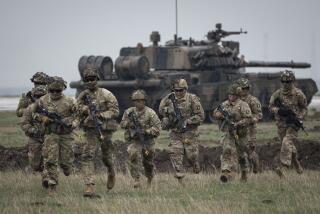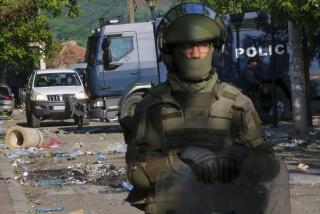U.S. Seeks 40,000 for Peacekeeping Force
- Share via
BRUSSELS — NATO’s top U.S. military commander has decided that he will need at least 40,000 troops--an increase of more than 40% over earlier estimates--to keep peace in Kosovo once the fighting ends, alliance sources said Monday.
The revised peacekeeping plan, drafted by Gen. Wesley K. Clark, is based on the assumption that Yugoslav President Slobodan Milosevic will ultimately accept NATO’s conditions for a truce, allowing the troops to enter the province unopposed.
But Britain revived its proposal--opposed by the Clinton administration and most other NATO members--to send ground combat troops once the Yugoslav army has been so badly mauled by the air campaign that it is no longer considered an effective fighting force. Washington is unwilling to commit U.S. troops until there is a signed agreement to end the hostilities.
Meanwhile, NATO warplanes continued to pound Yugoslavia while a fast-growing corps of European diplomats sought a political solution to the crisis. Among them, Russian peace envoy Viktor S. Chernomyrdin and U.S. Deputy Secretary of State Strobe Talbott plan to meet today in Finland’s capital, Helsinki, with Finnish President Martti Ahtisaari to plan a heightened role for Finland in the Kosovo mediation process.
German Chancellor Gerhard Schroeder, holder of the rotating presidency of the European Union, conferred with Ahtisaari on Monday in Helsinki, assuring him of the “full support” of the EU in the mediation process.
In Moscow on Monday, Spanish Prime Minister Jose Maria Aznar predicted that there will be “a serious breakthrough” in the bid for peace in the next few days. Aznar, who did not say how he expected the breakthrough to come about, spoke to reporters after talks with Chernomyrdin.
Despite the accelerating pace of diplomatic activity, Milosevic continued to reject NATO’s conditions for ending the fighting over Kosovo, a province of Yugoslavia’s dominant republic, Serbia. Britain, emerging as the alliance’s leading hawk, said NATO must be ready to dispatch an international force whether Milosevic likes it or not.
“We are not going to hang around in Macedonia until there is a grand signing ceremony in front of the flags and the cameras,” British Foreign Secretary Robin Cook told reporters at NATO headquarters in Brussels. “But we do need to know when it would be appropriate, when it would be safe, when it would be right to enter Kosovo. And that is a matter of continuing dialogue among ourselves without any difference over the objective.”
But Western Europe’s two other leading military powers made clear that they disagreed. Speaking after a meeting in Brussels of foreign ministers of the European Union, Joschka Fischer of Germany said his government would not support ground troops without the Yugoslav government’s consent. French Foreign Minister Hubert Vedrine also distanced himself from the British.
Gen. Nebojsa Pavkovic, commander of the 3rd Yugoslav Army in southern Serbia, was quoted by Belgrade’s weekly Svedok as threatening “hell on Earth” for NATO ground troops if they try to fight their way into the province.
No matter how the argument over the British proposal comes out--and because NATO decisions must be unanimous, the British have a lot of persuading to do--Clark determined that at least 40,000 troops would be required to patrol Kosovo even after the fighting ends, according to NATO diplomats and sources at Clark’s headquarters in Mons, Belgium. These officials said that Clark’s plan would be forwarded to NATO’s political leadership later this week.
Already, NATO countries have massed 16,000 well-armed soldiers backed up by armor in Macedonia, on Kosovo’s southern border. Those troops would form the nucleus of the peacekeeping force.
Pentagon officials said the peacekeeping force must be reshaped in part because of the physical damage that has taken place in Kosovo since the air war began March 24.
The new NATO force would probably have, for example, more military engineers to advise on how to rebuild Kosovo’s battered infrastructure; units to sweep mines from roads, bridges and fields; and “civil affairs” specialists to give advice on rebuilding the province’s government and court system, one officer said.
NATO realizes, this officer said, that any new plan for a peacekeeping force would probably have to be modified later, once NATO works out a peace treaty with Milosevic.
Officials also said the total force would have to be substantially larger than the originally anticipated 28,000 to accommodate troops from Russia and other countries that might wish to participate. Although U.S. and allied officials say the force must have a NATO command structure, they say they now expect the force to contain a number of troops from outside the alliance.
In other developments Monday:
* Serbian officials refused to allow a train carrying about 1,500 to 2,000 refugees to unload at the Macedonian border and turned it back into Kosovo, said Ron Redmond, a spokesman in Skopje, Macedonia, for the Office of the U.N. High Commissioner for Refugees. The closing of the border followed a day in which about 1,000 refugees streamed across for the first time in close to two weeks. “The flow is beginning again, but it is being turned on and off like a tap,” Redmond said.
* Very low cloud cover and intermittent rain forced cancellation of most of the planned NATO airstrikes during the 24 hours ending Monday morning, NATO officials said. Eighty-three missions were nevertheless flown against Serbian armor, military vehicles and artillery positions in Kosovo and components of the Yugoslav air defense network, the officials said.
* Two Serbian prisoners of war will be released soon, possibly as early as today, and will return to Yugoslavia, Pentagon spokesman Kenneth H. Bacon said. The two, captured by Kosovo Liberation Army guerrillas and turned over to U.S. forces, were asked to provide evidence to the Balkan war crimes tribunal in The Hague but declined to do so. Under the Geneva Convention, they could not be forced to talk to prosecutors, Bacon said. He insisted that the release should not be considered a goodwill gesture to Milosevic or a quid pro quo for the release earlier of three U.S. POWs.
* Eighteen more A-10 Warthog aircraft--and the Air Force reservists who fly and maintain them--left Barnes Municipal Airport in Massachusetts for the Balkans. Later this week, 24 F/A-18s will follow them. Bacon said the planes “are part of the 176 additional aircraft that we announced several weeks ago.”
* Pentagon and British officials said Serbia’s use of ethnic Albanians as human shields has made it more difficult for allied warplanes to pick targets. Cook, the British foreign secretary, declared, “We have now gathered 80 separate reports from refugees in Macedonia of the use of human shields by the Serb forces.”
* All but two of 106 ethnic Albanian refugees seized in Montenegro over the weekend by Yugoslav soldiers were freed, authorities in Montenegro said. The unexpected move helped ease tensions between the civilian and military authorities after soldiers set up roadblocks at a number of Montenegrin border crossings and prevented a much-needed shipment of flour from entering Montenegro, the Western-leaning republic that is Serbia’s junior partner in the Yugoslav federation.
* In the southeastern Serbian city of Krusevac, a large gathering of women staged a protest demanding that reservists sent to Kosovo be allowed to come home, Montenegrin television reported. That report estimated the number of participants at 5,000. Members of Serbia’s opposition Democratic Party familiar with the demonstration put the figure at somewhat more than 1,000 protesters. The demonstrators were mainly wives and mothers of reservists who have been serving in Kosovo for two or three months, said a Democratic Party member who spoke on condition of anonymity. Another Democratic Party member said the remains of 20 soldiers had been returned to Krusevac in the last two or three days.
In Belgrade, the Yugoslav and Serbian capital, a 15-member U.N. team arrived Monday to prepare for the first trip to Kosovo by an international agency since the bombing began. They were expected to arrive in the rebellious province Thursday--in four-wheel drive vehicles followed by a diesel fuel tanker--to assess the humanitarian needs of a population uprooted by war.
The U.N. team expects to spend 2 1/2 days traveling in the war zone. The group includes a land mine specialist as well as experts on humanitarian relief and human rights.
Sergio Vieira de Mello, a U.N. undersecretary-general who is leading the mission, admitted that some people have told him it is “madness” to travel in Kosovo. But “we cannot wait for a settlement of the problem to assist those who are in desperate need inside Kosovo,” he said. “We must find a way of getting help to these people, including protection if at all possible.”
In Washington, Julia Taft, the administration’s chief refugee official, said the United States is concerned that de Mello’s group will spend only two days in Kosovo while spending the rest of a 10-day trip elsewhere in Serbia and in Montenegro. She said that is not enough time to assess the situation in the province.
Dahlburg reported from Brussels and Kempster from Washington. Times staff writers Richard Boudreaux in Belgrade, David Holley in Podgorica, Yugoslavia, Marjorie Miller in London, Richard C. Paddock in Moscow, Paul Richter in Washington and Alissa J. Rubin in Skopje contributed to this report, along with Sarah White of The Times’ Paris Bureau.
More to Read
Sign up for Essential California
The most important California stories and recommendations in your inbox every morning.
You may occasionally receive promotional content from the Los Angeles Times.













